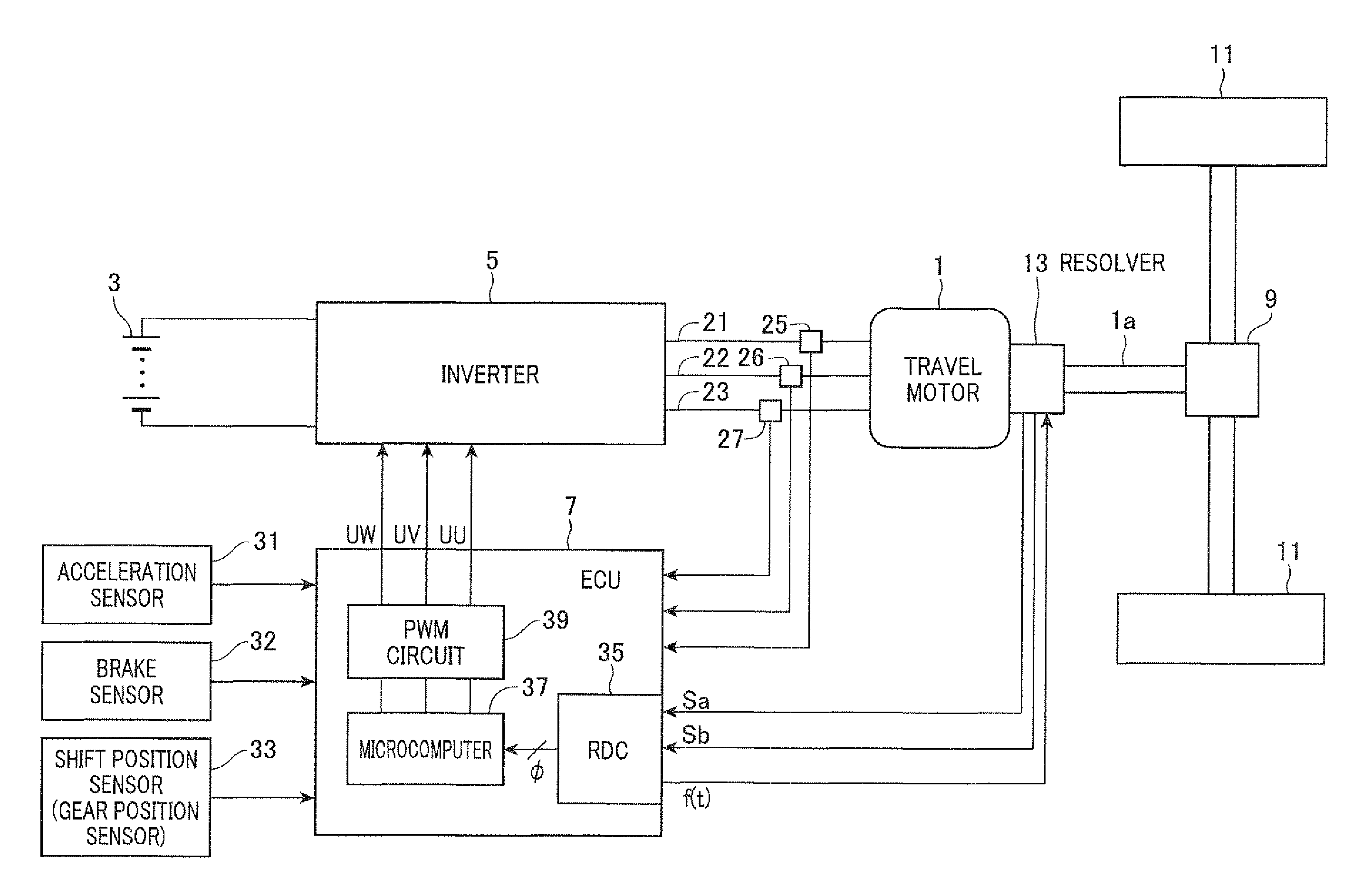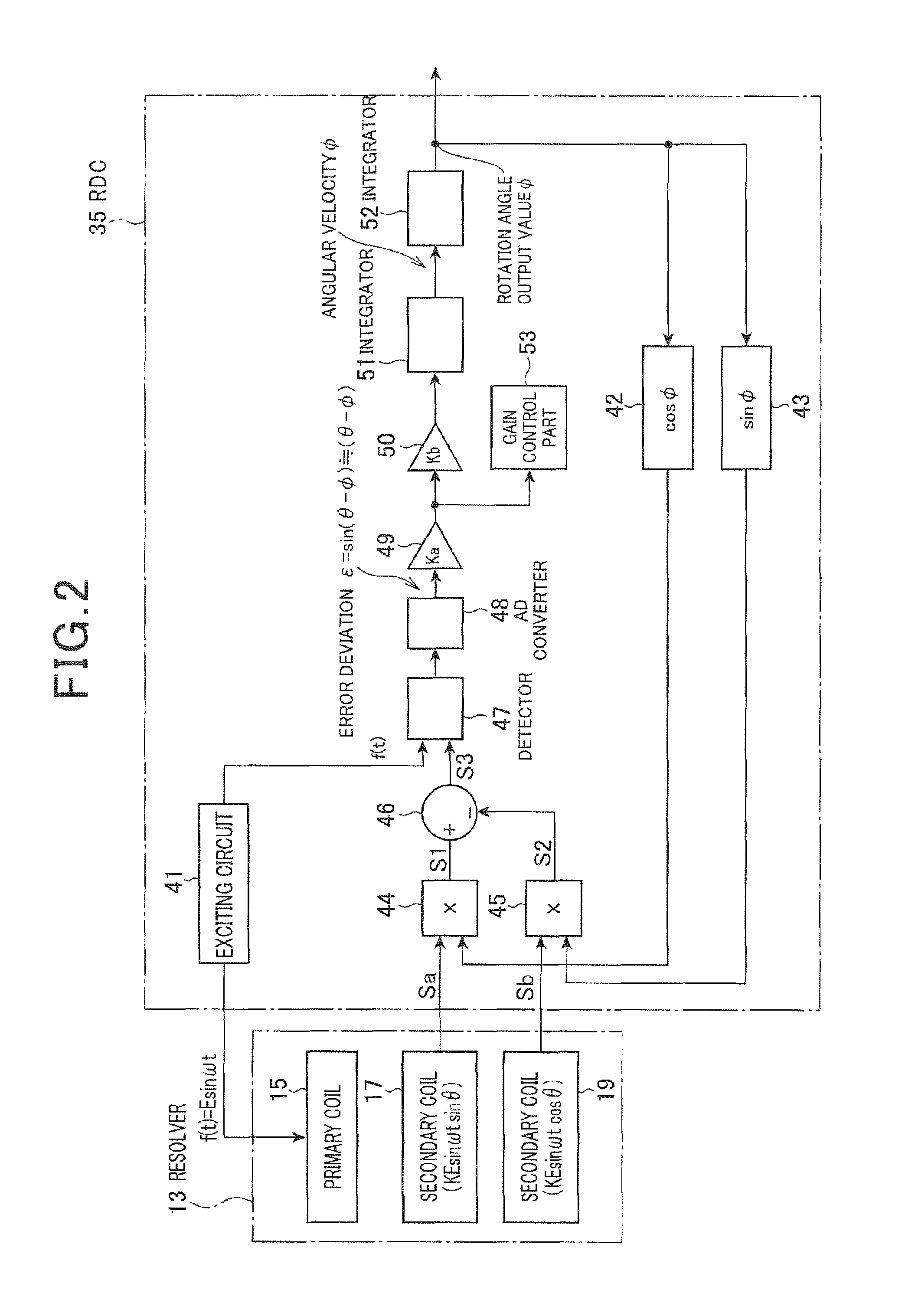Control device for controlling travel motor of vehicle
a technology of control device and travel motor, which is applied in the direction of program control, electric energy management, compasses, etc., can solve the problems of reducing the detection reducing the control accuracy of the rotary body such as the travel motor, and reducing the accuracy of the rdc to detect the rotation angle of the travel motor. , to achieve the effect of suppressing the decrease of accuracy, reducing gain, and superior performan
- Summary
- Abstract
- Description
- Claims
- Application Information
AI Technical Summary
Benefits of technology
Problems solved by technology
Method used
Image
Examples
first embodiment
[0052]A description will be given of the control device capable of controlling the operation of a travel motor mounted to an electric vehicle according to the first embodiment of the present invention with reference to FIG. 1 to FIG. 5.
[0053]FIG. 1 is a view showing a circuit configuration of the control system for an electric vehicle comprised of a resolver 13, an inverter 5, a travel motor 1, and an ECU (control device) 7 having an RDC 35 according to the embodiments of the present invention.
[0054]As shown in FIG. 1, the electric vehicle is equipped with the travel motor 1 composed of an AC synchronous motor which is known and available in the commercial markets, a battery 3 which serves as a DC power source, the inverter 5 which is also known device and drives the travel motor 1, and the ECU 7 (control device) which is comprised of a resolver digital converter 35, a microcomputer 37, and a PWM circuit 39. The RDC 35 is capable of controlling the operation of the travel motor 1. A...
second embodiment
[0125]A description will be given of the control device according to the second embodiment of the present invention with reference to FIG. 6.
[0126]FIG. 6 is a flow chart showing the process to detect the rotation state of the travel motor 1 performed by the gain control part 53 in the RDC 35 of the ECU 7 according to a second embodiment of the present invention.
[0127]When compared with the process to detect the rotation state of the travel motor 1 performed by the gain control part 53 in the RDC 35 of the ECU 7 according to the first embodiment, the gain control part 53 according to the second embodiment performs the process to detect the rotation state of the travel motor 1 shown in FIG. 6 every updating the output of the multiplier 49.
[0128]As shown in FIG. 6, the gain control part 53 increments a counter Ca by 1 (step S320) when the multiplier 49 outputs a positive output value (=ε·Ka) (“YES” in step S310). On the other hand, the gain control part 53 increments a counter Cb by 1 ...
third embodiment
[0135]A description will be given of the ECU 7 as the control device according to the third embodiment of the present invention with reference to FIG. 7. FIG. 7 is a flow chart showing the process to detect the rotation state of the travel motor 1 performed by the gain control part 53 in the RDC 35 of the ECU 7 as the control device according to the third embodiment of the present invention. When compared with the configuration of the ECU 7 according to the first embodiment, the gain control part 53 in the RDC 35 in the ECU 7 according to the third embodiment performs the process to detect the rotation state of the travel motor 1 shown in FIG. 7 instead of the process to detect the rotation state of the travel motor 1 shown in FIG. 4 every updating the output of the multiplier 49.
[0136]As shown in FIG. 7, the gain control part 53 in the RDC 35 detects whether or not the absolute value of the output (=ε·Ka) of the multiplier 49 is not more than a predetermined threshold value Dth (st...
PUM
 Login to View More
Login to View More Abstract
Description
Claims
Application Information
 Login to View More
Login to View More - R&D
- Intellectual Property
- Life Sciences
- Materials
- Tech Scout
- Unparalleled Data Quality
- Higher Quality Content
- 60% Fewer Hallucinations
Browse by: Latest US Patents, China's latest patents, Technical Efficacy Thesaurus, Application Domain, Technology Topic, Popular Technical Reports.
© 2025 PatSnap. All rights reserved.Legal|Privacy policy|Modern Slavery Act Transparency Statement|Sitemap|About US| Contact US: help@patsnap.com



